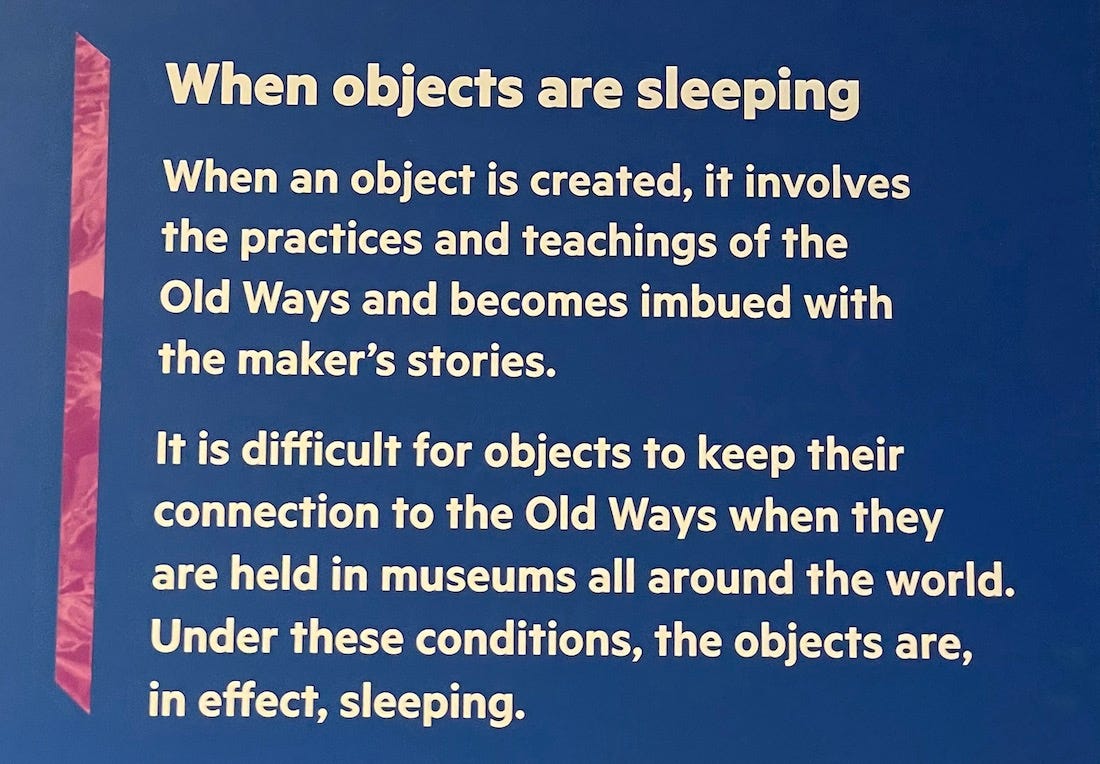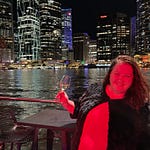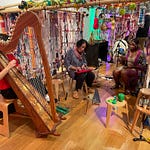I hope you my dear listener, can take half an hour out of your hectic “getting everything done before Christmas" prep, put on your headphones and close your eyes as you walk through the Queensland Museum with Rhianna, and let the audio guide you as you immerse yourself in this fascinating First Nations culture. You can hear songs from the islands, and some of the many languages that are still spoken. Brisbane listeners amongst our Streets of Your Town tribe may even want to go to the exhibition and listen to this podcast as you walk through for a special guided tour.
It’s been a bit of a long time between drinks here at Streets of Your Town—but to make up for it we’ve got a jam packed newsletter for you that will hopefully get you into the holiday vibes even briefly in that rush up to Christmas—because we are taking you to the Torres Strait.
While many people have heard of the Torres Strait Islands at the northern tip of Australia, not as many know the fascinating history and influence this archipelago paradise has played in the nation's history and future.
From the tip of Cape York to the borders of Papua New Guinea and Indonesia, the Torres Strait—or now increasingly known as Zenadth Kes—covers an area of more 200 islands over 48 thousand square kilometres.
The Queensland Museum is bringing a touch of this beauty and complexity to Brisbane until the end of April 2022, giving city people a rare glimpse of these remote islands in the exhibition: Island Futures: What lies ahead for Zenadth Kes?
This episode of Streets of Your Town podcast takes you on a behind the scenes tour of that exhibition with co-curator, renowned broadcaster and proud Torres Strait Islander Rhianna Patrick.
She explains how hard it is to capture such a complex society of interwoven stories—the interconnectedness between people, place and knowledge which is the foundation of their identity.
In the late 1980s, Torres Strait Islander cultural leaders tried to reclaim the name of the region by creating the acronym Zenadth Kes. It describes the winds and geography of the Torres Strait Islands and region.
“That’s what we are trying to show—Torres Strait Islander is a very generic term. Placing it with the word Zenadth Kes and explaining what Zenadth Kes means which is Torres Strait but it’s an acronym,” Rhianna says.
“Acknowledging all of the nations in the Torres Strait that we have and the five cluster groups which are represented on our flag. And to have this big map you can see how spread out we are between the tip of Cape York and Papua New Guinea.”
Rhianna tells stories of her people as she guides us through the exhibition, and also explains pivotal moments in the nation’s history.
One of those historic moments could actually result in an update of the exhibit, as the world awaits the result of a pivotal court challenge by the Torres Strait Eight, seeking justice from the United Nations for today’s crisis on the islands around rising sea levels.
In the world’s first case of its kind—eight Torres Strait Islanders have taken a complaint against the Australian Government to the UN, for failing to protect Zenadth Kes from climate damage—demanding that Australia rapidly reduce emissions.
“We’ve always had these points of resistance and resilience but many people don’t know about that, they don’t know what we’ve fought for, they don’t really understand who we are, where we come from,” Rhianna says.
“When our forefathers saw something wasn’t right they didn’t sit back, they took it on board and they tried to make change.”
As Rhianna explains, this isn’t the first time that Islanders have faced this type of crisis.
“After World War II Australia had its first climate migrants,” she says.
“There were seven families from Saibai who left, came down to settle after getting permission from the traditional owners at the tip of Cape York to create a community.
“When they were inundated with water there was a lot of mosquitoes, there was a lot of disease, there was a lot happening on the island, and so these families decided to leave to find somewhere else. And so that first relocation of an island being inundated by water and people feeling like they needed to move has already happened. This has been a conversation—rising seas—for many decades in the Torres Strait.”
Rhianna and her co-curator Imelda Miller overcame the challenges of Covid by bringing the team together in a Brisbane park to create the vision for the exhibit, where they could all socially distance, and safely tell their cultural stories of significance.
She says it was vitally important to use the traditional names for the islands, the way people call them and how they’re known, as well as traditional concepts of time, with the English underneath.
“There are over 200 islands but 18 communities. It’s showing that it’s not just Thursday Island. People think, ‘I went to the Torres Strait’. ‘Oh, where did you go?’ ‘Thursday Island’. And that’s great, but it’s only one representation and once you get out of there…Thursday Island was the administration centre for the Torres Strait during the time that people were under The Act, so it has that history as well.
“Once you start to go out to the other islands you realise that it’s very different.
“That’s what I’m hoping is that people get a sense that even though we might seem all the same, there are all these regional differences with where our islands are and what they’re made up of. There’s language differences. There’s differences in people and protocols and cultures sometimes as well that differs. So it’s really important that people understand that we’re not just one group of people, we have these many other groups that define us as well.”
On the podcast Rhianna tells the stories behind a number of works on display, from well-known artists including cinematographer Murray Liu, artists Dylan Mooney and Christopher Bassi, and filmmaker Margaret Harvey.
“We don’t often get to see ourselves represented on television. There’s very few dramas about us involving us. We don’t have any feature films apart from Mabo. We’re still really underrepresented when it comes to media in general. And so we liked that Islanders sit here watching Islanders on a television in a lounge room.”
Many of the photos of Torres Strait Islanders in the collection at Queensland Museum of more than 1500 historic photographs are lacking names and identification. The Museum has asked that if anyone recognises the people in the photos to please let the museum know so this historical oversight can be corrected.
More from the Torres Strait Islands
In what I found to be an incredible coincidence, I have had a number of fascinating brushes with Zenadth Kes culture this month while preparing this podcast with Rhianna.
My Gender Card podcast from the Torres Strait with Dr Michelle Jackson
The great podcast series I’m producing for the Gender Equity Research Network (GERN) at Griffith University is The Gender Card, and this month I also went to the Torres Strait with Dr Michelle Jackson, who brought back interviews from her recent visit with Islanders about the impact of climate change. It’s truly heartbreaking to hear Torres Strait Islanders tell how much has changed in such a short period of time—and they should know with thousands of years of connection to this country to go by. They tell in this podcast how their freshwater supplies are cut off for hours each day because of extreme weather events caused by climate change. The more people listen, the more hope we have of changing it.
There’s also the most beautiful reading of the children’s book Aunty Mati The Watersaving Superhero, that was recently released to encourage children to do what they can in the face of the damage climate change is bringing to the islands. (You can download the PDF of the book here.)
National Indigenous Radio Service
I was also invited back to the wonderful Brisbane resource at the Brisbane Indigenous Media Association studios at 98.9FM in West End—where I was lucky enough to report on stories for the National Indigenous Radio Service (NIRS). The stories are broadcast around the country to dozens of their affiliated community radio stations.
You can hear my NIRS voice report on the world famous Cairns Indigenous Art Fair which recently made a triumphant return after being forced online by Covid last year.
More from the Torres Strait Islands
Continuing the Torres Strait Island theme, here’s more links to stories on this fascinating culture.
Drawing from Jimi Bani’s own family story, Queensland Theatre’s Othello reveals the little-known history of the Torres Strait during World War II, bombed 500 times and defended by the only Indigenous Battalion in the history of the Australian Army.
In September, this fascinating and little understood chapter of Australian history is being highlighted in an innovative production of Othello by Queensland Theatre. The production has already had its debut in Cairns, at the CIAF festival, so make sure you don’t miss it when it rolls around to Brisbane.
New album from Chris Tamwoy
Chris Tamwoy is an incredible Torres Strait Islander musician who I have had the pleasure to meet and interview a number of times, right back from when he was still in school for a feature I did on Logan for ABC Radio! He’s just released his first full length album “Reality Is” and it’s SUPERB. (Listen at Apple Music or Spotify). I was lucky enough to watch him live recently on a rare fine but not intensely hot spring day in Brisbane. And it was sublime.
Aboriginal and Torres Strait Islander perspectives in journalism at QUT
I was also lucky enough to be invited to take part in creating a vision for a more inclusive media in Australia, at QUT’s special forum “Aboriginal and Torres Strait Islander perspectives in journalism—co-designing a more inclusive media future”.
The legacy of David Gulpilil
And just to finish, I couldn’t help but mention the incredible legacy left behind by David Gulpilil after his recent passing. Australian cinema is unimaginable without his contribution. I was lucky enough to interview him in Adelaide, in a brush with fame I will never forget. (Transcript of interview.)
Behind the Scenes
Thankyou to all of you my Wandering Journo tribe for supporting me to bring this podcast to you in all the immersive “wrap around audio” that I love to do—and which you help me to make by subscribing to my newsletter! I hope you enjoyed walking along with Rhianna in your mind and hearing the stories of this fascinating part of Australia.
And if you’re looking for Christmas presents…what better way to do it than support Press Freedom and diversity in Australia through supporting indie podcasters like myself—and buy a subscription for yourself or a friend? Got that rellie you never know what to get them? Support your indie podcasters and help me keep filling up the tank on Mildred my cantankerous Kombi so I can get to all these fabulous untold stories by pressing on the button below.
All the people who get a new subscription or renew their subscription will receive my eternal gratitude, and more importantly—merch! You will get one Wandering Journo magnet and one Wandering Journo pen. I know how fussy journos are about pens, I should know because I’ve nabbed a few from press conferences in my time—so I made sure these pens are the ducks’ nuts!
And if you renew your subscription for a year—I will send you a one of a kind Wandering Journo thermos style water bottle too that keeps your drinks hot or cold! What a great deal is that!
Talk again soon my Wandering Journo tribe! Thanks so much for your ongoing support—and please share this with your friends.
Nance
Streets of your Town podcast would like to acknowledge the traditional custodians on whose land this story was gathered.
I acknowledge that for tens of thousand of years Our First Nations people have walked this country and shared stories on this great land down under, and I walk in their footsteps today.
I pay my respects to their Elders, past, present and emerging.





















Share this post